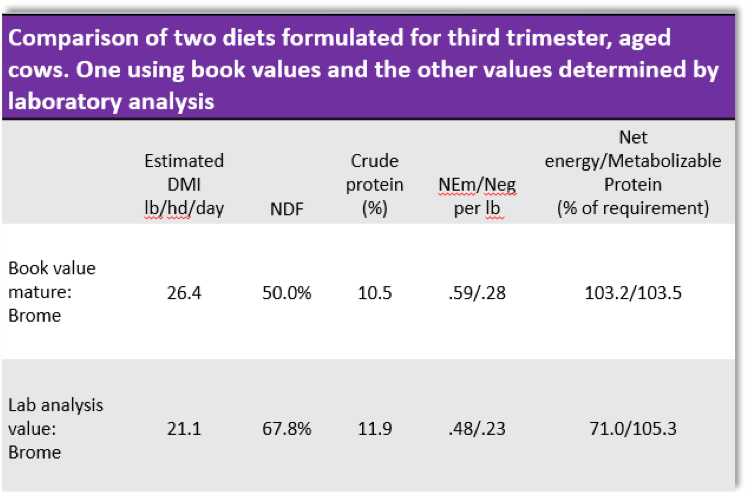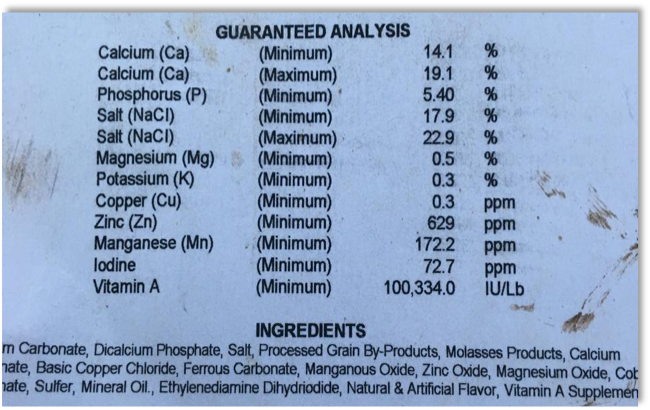
May 2019
Difficult Calving Season Findings: 2019
By Dr. Gregg Hanzlicek
|
|
| Figure 1. Photo of mineral tag containing very low levels of trace minerals and Vitamin A fed to cow-calf herds. |
The KSVDL received many calls and investigated multiple cases of stillborn and weak calf syndrome this last spring.
The number of individual herds and the number of animals within herds experiencing the syndromes was, in our experience, unprecedented. After ruling out the most common diseases and toxins that are associated with these syndromes, we were able to determine that nutritional issues were involved in many of the cases.
Some of the nutritional deficiencies that can impact calf survivability are Vitamin A, Vitamin E, selenium, and protein and/or energy.
What was discovered?
We found many herds were fed diets that were deficient in either Vitamin A, energy, protein or a combination of both energy and protein.
In many of the Vitamin A deficient herds, producers were not offering trace mineral/vitamin supplements to their animals after the pasture season. Green pastures provide large amounts of Vitamin A to ruminants, which they can store in their livers. On average those stores are depleted within 2-4 months after being placed on a Vitamin A deficient diet.
Several other producers were providing supplements that were extremely low in both trace minerals and Vitamin A, (Figure 1), or were feeding supplements that had been stored for long periods of time (some up to two or more years). Vitamin A is extremely susceptible to oxidation over time. Data collected from many manufacturing and research projects over multiple years was summarized by Coelho. He found that on average, Vitamin A loss during storage to be 11 percent per month in premixes containing trace minerals in the sulfate form.1
One of the other common issues we found included herds that were feeding rations balanced for their heifers and cows using “book values” for energy, protein, and fiber. Many times the forage that was actually fed was not accurately represented by the values listed in reference books. The “book value” ration below was balanced for both energy and protein; it supplied 103% of both the energy and protein requirements as shown in the far-right column. The actual diet fed (using values determined by laboratory analysis) was sufficient in protein (105% of requirement) but very deficient in energy (only supplied 71% of the energy requirements). Table 1

|
| Table 1. |
Why would nutritional issues be common this year?
A common question from producers whose herds were nutritionally deficient was “We have always fed this way and have never seen issues like this, why would we have an issue this year?” We certainly don’t have all the answers, but it might be that in the past when environmental conditions were not as severe this year, diets were sufficient although still perhaps marginally deficient. However, this year the extreme conditions (extremely cold temperatures, elevated moisture levels/mud, etc.) increased metabolic demands on late gestation cows and heifers which may have altered their nutritional status from sufficient to deficient.
Where were other issues discovered in the problem herds?
In several of the problem herds, the veterinarians were able to collect serum samples from multiple calves (non-affected calves) to assess colostrum antibody protection. The results (not shown) suggested the percentage of calves without adequate maternal antibodies to be much higher than expected. It is possible/probable that the dietary deficiencies experienced by the dams may have reduced the quantity and quality of colostrum produced this spring.
Is the problem over now that herds have finished calving and are out on pasture?
Many of the practitioners and KSVDL veterinarians involved in these cases are wondering if the amount of health problems (e.g. summer pneumonia and IBK) to be experienced in herds during this coming pasture season may be higher than usual given the level of colostral protection failure. We certainly hope we are wrong.
In a forthcoming article, nutritional diagnostic monitoring strategies will be discussed.
- Coelho, M.B., 2002. Vitamin stability in premixes and feeds: A practical approach in ruminant diets. Proceedings 13th Annual Florida Ruminant Nutrition Symposium. Pages 127-145.
NEXT: A Case Study of Erythema Multiforme in an 11-month-old Pembroke Welsh Corgi
Return to Index
